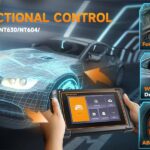For Polaris vehicle owners keen on understanding their machine’s inner workings, delving into the Controller Area Network (CAN) bus system can unlock a wealth of diagnostic information. Like many modern vehicles, Polaris utilizes CAN bus for communication between various electronic control units (ECUs). While not strictly adhering to the standard OBD2 protocols found in passenger cars, Polaris systems, particularly those using J1939, can be accessed using tools familiar to automotive technicians, including Polaris Obd2 Adapters.
Initial exploration into the raw CAN bus data of a Polaris vehicle reveals it largely operates on the J1939 protocol. This standard, common in heavy-duty vehicles and off-highway equipment, defines how data is structured and transmitted. Within the J1939 framework, Parameter Group Numbers (PGNs) and Suspect Parameter Numbers (SPNs) are used to identify specific data points. The ID field in the CAN bus message dictates both the source of the data and the PGN. For instance, deciphering a CAN ID like 0CFF6600 involves converting the PGN portion (FF66, or 65382 in decimal) to understand the data it represents. Online tools like the J1939 Online 29-bit CAN ID to PGN Converter are invaluable for this process.
Manufacturer-defined PGNs also play a role in Polaris diagnostics. For example, PGN 65382 (FF66) is identified as manufacturer-specific. By observing data changes while interacting with the engine, it becomes evident that this particular PGN relates to engine RPM. Resources like the ISOBUS Data Dictionary – View PGNAndSPN can provide further context, although manufacturer-specific data often requires hands-on investigation and comparison with resources shared by other enthusiasts, such as the work documented in repositories like milodarling/RZR_CAN_HACKS.
Analyzing captured CAN bus data logs reveals a variety of parameters broadcast by the Polaris ECU. These include:
- Engine Speed (RPM): Reported via PGNs like 65382 (0CFF6600) and standard J1939 PGNs, providing real-time engine speed data.
- Gear Selection: Indicated through PGN 61445 (18F00500), with data bytes encoding gear positions (Park, Reverse, Neutral, Low, High) in ASCII format.
- Vehicle Speed: Transmitted via PGN 61425 (18FEF100) and potentially others, giving insights into the vehicle’s current speed.
- Engine Temperature: Broadcasted using PGN 61422 (18FEEE00), with data bytes correlating to temperature readings in Fahrenheit.
- Throttle Position: Available through PGN 61426 (18FEF200), providing percentage values for throttle input.
- Fuel Level: Reported by the fuel level sensor via PGN 65403 (18FEFC17).
- Power Steering: Data related to power steering function can be found on PGN 63847 (18FF6713).
- 4-Wheel Drive Status: Indicated via PGN 66527 (1CFDDF00), with data bits showing whether 4WD is engaged or disengaged.
- Vehicle Distance Driven: Logged through PGN 60993 (18FEC117), accumulating distance in 5-meter increments.
While applications like Torque Pro, when configured for J1939, can interpret some standard parameters from Polaris CAN bus data, limitations exist. Specifically, Torque Pro and similar generic OBD2 apps often lack the capability to readily incorporate custom PGN definitions. Attempts to use standard PID functionalities for custom PGNs may not yield the desired results for J1939 data. Furthermore, the development and update frequency of some of these apps can be a concern when seeking support for newer or less common protocols. Testing various Android and iOS apps with ELM327 adapters reveals inconsistent J1939 support, highlighting the need for more specialized tools.
To overcome these limitations, exploring professional-grade diagnostic tools designed for J1939, such as those used in heavy-duty trucking (e.g., Nexiq), becomes relevant. Connecting such tools via appropriate Polaris OBD2 adapters and J1939-compatible cables could provide enhanced data readability, including the ability to read and clear diagnostic trouble codes – a critical function for vehicle maintenance. Similarly, investigating iOS apps specifically advertised to support J1939 protocols in conjunction with Wi-Fi ELM327 adapters offers another avenue for improved diagnostics.
For DIY enthusiasts and those seeking highly customized solutions, the raw CAN bus data opens possibilities for creating bespoke monitoring systems. Arduino-based platforms, for instance, can be programmed to parse specific CAN messages and output data to various displays or interfaces, potentially even integrating with systems like the Voyager Pro GPS. While commercial CAN bus modules for systems like Voyager Pro are under development, the foundational work of deciphering the Polaris CAN bus protocol paves the way for a range of diagnostic and performance monitoring solutions.
In conclusion, accessing and interpreting Polaris vehicle data through Polaris OBD2 adapters and tools like ELM327 and Torque Pro is achievable, albeit with certain limitations, particularly concerning custom PGNs and comprehensive J1939 support in generic OBD2 apps. Further exploration with professional J1939 diagnostic tools and dedicated mobile applications promises to unlock more in-depth diagnostic capabilities. For those inclined towards DIY, the detailed understanding of Polaris CAN bus communication provides a solid foundation for building custom data monitoring and display systems, empowering Polaris owners with greater insight into their vehicle’s operation and health.
